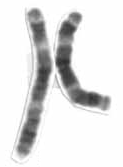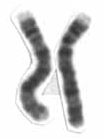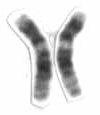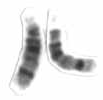
Chromosome 1 is the designation for the largest human chromosome. Humans have two copies of chromosome 1, as they do with all of the autosomes, which are the non-sex chromosomes. Chromosome 1 spans about 249 million nucleotide base pairs, which are the basic units of information for DNA. It represents about 8% of the total DNA in human cells.

Chromosome 3 is one of the 23 pairs of chromosomes in humans. People normally have two copies of this chromosome. Chromosome 3 spans almost 200 million base pairs and represents about 6.5 percent of the total DNA in cells.

Chromosome 4 is one of the 23 pairs of chromosomes in humans. People normally have two copies of this chromosome. Chromosome 4 spans more than 186 million base pairs and represents between 6 and 6.5 percent of the total DNA in cells.

Chromosome 9 is one of the 23 pairs of chromosomes in humans. Humans normally have two copies of this chromosome, as they normally do with all chromosomes. Chromosome 9 spans about 138 million base pairs of nucleic acids and represents between 4 and 4.5 percent of the total DNA in cells.

Chromosome 10 is one of the 23 pairs of chromosomes in humans. People normally have two copies of this chromosome. Chromosome 10 spans about 133 million base pairs and represents between 4 and 4.5 percent of the total DNA in cells.

Chromosome 11 is one of the 23 pairs of chromosomes in humans. Humans normally have two copies of this chromosome. Chromosome 11 spans about 135 million base pairs and represents between 4 and 4.5 percent of the total DNA in cells. The shorter arm is termed 11p while the longer arm is 11q. At about 21.5 genes per megabase, chromosome 11 is one of the most gene-rich, and disease-rich, chromosomes in the human genome.

Chromosome 12 is one of the 23 pairs of chromosomes in humans. People normally have two copies of this chromosome. Chromosome 12 spans about 133 million base pairs and represents between 4 and 4.5 percent of the total DNA in cells.

Chromosome 14 is one of the 23 pairs of chromosomes in humans. People normally have two copies of this chromosome. Chromosome 14 spans about 107 million base pairs and represents between 3 and 3.5% of the total DNA in cells.

Protein FAM46A is a protein that in humans is encoded by the FAM46A gene. Aliases for Fam46A include HBV X-Transactivated Gene 11 Protein, C6orf37, and XTP11. The gene contains 6 introns, and is 6982 base pairs long. The transcribed mRNA is 2231 base pairs long and contains 2 exons, 589 and 1128 base pairs, with 4 alternative splice isoforms.

Protein ITFG3 also known as family with sequence similarity 234 member A (FAM234A) is a protein that in humans is encoded by the ITFG3 gene. Here, the gene is explored as encoded by mRNA found in Homo sapiens. The FAM234A gene is conserved in mice, rats, chickens, zebrafish, dogs, cows, frogs, chimpanzees, and rhesus monkeys. Orthologs of the gene can be found in at least 220 organisms including the tropical clawed frog, pandas, and Chinese hamsters. The gene is located at 16p13.3 and has a total of 19 exons. The mRNA has a total of 3224 bp and the protein has 552 aa. The molecular mass of the protein produced by this gene is 59660 Da. It is expressed in at least 27 tissue types in humans, with the greatest presence in the duodenum, fat, small intestine, and heart.

FAM135B is a human gene coding for a protein of unknown function. It is well conserved in primates, rodents, zebra fish. It has one paralog, FAM135A.

The FAM185A is a protein that in humans is encoded by the FAM185A gene. The FAM185A gene is found on the positive strand of Chromosome 7 at 7q22.1. The gene begins 102,389,399bp from the p-terminus of the chromosome and ends at 102,449,672bp from the p-terminus; it covers a total of 73,308 basepairs. The protein encoded by this gene is characterized by the presence of multiple copies of DUF4098 near its C-terminus. It is described as a Long Interspersed Nuclear Element (LINE), a subclass of penaeid repetitive elements (PREs).

Family with Sequence Similarity 203, Member B (FAM203B) is a protein encoded by the FAM203B gene (8q24.3) in humans. While FAM203B is only found in humans and possibly non-human primates, its paralog, FAM203A, is highly conserved. The FAM203B protein contains two conserved domains of unknown function, DUF383 and DUF384, and no transmembrane domains. This protein has no known function yet, although the homolog of FAM203A in Caenorhabditis elegans (Y54H5A.2) is thought to help regulate the actin cytoskeleton.

Family with sequence similarity 167, member A is a protein in humans that is encoded by the FAM167A gene located on chromosome 8. FAM167A and its paralogs are protein encoding genes containing the conserved domain DUF3259, a protein of unknown function. FAM167A has many orthologs in which the domain of unknown function is highly conserved.

Family with sequence similarity 63, member A is a protein that, in humans, is encoded by the FAM63A gene. It is located on the minus strand of chromosome 1 at locus 1q21.3.
Family with Sequence Similarity 166, member B, or FAM166B, is an uncharacterized protein in humans that is encoded by the FAM166B gene.
FAM63B is a protein which in humans is encoded by the gene FAM63B. This gene is highly expressed in humans. The FAM63B gene is also highly conserved throughout evolutionary history. The discovered function of FAM63B is an interaction with the kinesin-1 light chain and the transportation of vaccinia virus from the nucleus to the cell periphery.
FAM231B, or family with sequence similarity 231B, is a protein found in humans and is encoded by FAM231B gene. Orthologs of FAM231B are only found back to primates.

FAM71F2 or Family with Sequence Similarity 71 member F2 is a protein that in humans is encoded by the Family with Sequence Similarity 71 member F2 gene. This gene is highly active in the reproductive tissues, specifically the testis, and may serve as a potential biomarker for determining metastatic testicular cancer.

Chromosome 9 open reading frame 25 (C9orf25) is a domain that encodes the FAM219A gene. The terms FAM219A and C9orf25 are aliases and can be used interchangeably. The function of this gene is not yet completely understood.
















